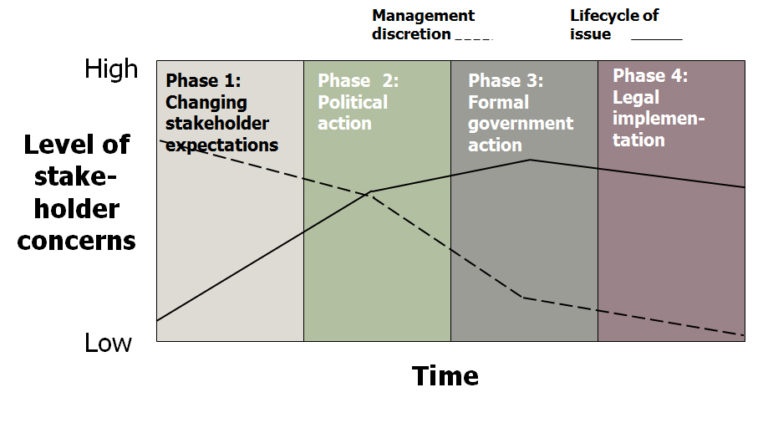Why the noisy few count: Every policy coalition has its vanguard
March 26, 2014
It is tempting to dismiss stakeholder groups that complain about your organization as representing the fringe of public opinion. Often the majority disagrees with them, and sometimes public opinion polls even prove it. The problem with ignoring such groups is the risk that they will become public opinion leaders.
For example, research by the Pew Research Center in Washington DC shows a complete turn-around in public opinion on the question of gay marriage. In 2003, a third of Americans were in favour of it and 58 percent were against. By 2013, half supported it and only 44% opposed it. The reversal in public opinion followed a classic path that sociologists call the “issues lifecycle”.
The issues lifecycle typically has four phases. In the first phase, a few people raise the issue and sway others to their viewpoint. When there is a critical mass, the issues moves to phase two. In phase two the activists form organisations aiming to change laws, regulations, or cultural norms, as the case may be.
In democracies, this means changing public opinion so that politicians will feel the pressure. When public opinion starts to change, the issue can move to phase three where the politicians start to legitimise it by launching studies on the legislative or regulatory changes that would be needed. In the final phase, the laws, regulations, or norms are changed and those affected by the changes are monitored for compliance.
Figure 1: The issue life cycle, based on Post, J. E., Lawrence, A. T., & Weber, J. 2002. Business and Society: Corporate Strategy, Public Policy, Ethics. New York: McGraw-Hill Irwin.

For example, the issue of compensation for asbestosis exposure by former employees of James Hardie Industries, Australia, went through the classic phases before it was finalized.
When the issue in question is about the activities of your organization or industry, your ability to have a say goes down to nearly zero by phase four. In phase one, however, it is difficult to even discern the existence of an issues, therefore again, it is difficult to have a voice on it. In phase three, public opinion has already shifted, or entrenched itself.
When to take action on issues
Once polarization has set in, further changes become much more difficult. Your maximum opportunity for influencing the issue is in phase two, as soon as it is identifiable as an aim of a stakeholder group.
Effective action in phase two can make public opinion either become more resistant to change or move in a direction you favor. For example, the longer-standing controversies over specific mining and energy projects in Australia’s states of New South Wales and Queensland now appear to be entering phase three. Because companies and industry groups have proactively engaged with stakeholders, governments are tending towards moderate positions short of what activists advocate. At the same time, there are many new projects, especially in the energy sector, that are still in phase two.
Effective action at phase two requires two things. First, you must identify the opinion leaders and the frame they are using to tell the ‘story’ of the issue. With this understanding you can find places where your organisation’s story overlaps, or could overlap, with theirs. Alternatively, you can develop a new story to explain the same facts and events.
Second, effective action also requires discovering where the stakeholder group is situated in your stakeholder network[1]. Are they part of a tightly connected cluster or more isolated? Are they connected to other influential organizations trusted by the public or to other groups with less credibility? With this information you can launch initiatives that will change the network structure, and consequently increase or decrease the influence of the stakeholder group.
The influence of public opinion versus stakeholder opinion in the lifecycle of issues
Getting these two kinds of information is quite different from getting a read on public opinion. Public opinion is estimated with random sample public opinion surveys. Everyone must have an equal chance of being selected. At phase two, public opinion survey results mostly reflect uninformed views from people who have not yet thought about the issue. Because of that, they often appear middle-of-the-road. At phase two it is more informative to interview a census (i.e., as close to 100% as possible) of stakeholder groups. This will give the information you need on the story frames they are experimenting with and their positions in the stakeholder network.
Effective action at phase two is easier for some organizations than others because of the level of public trust they enjoy. International research finds that academic and scientific organizations and NGOs are the most trusted. By contrast, business, government and news media are the least trusted.
This is one reason why NGOs are increasingly finding themselves invited to participate in forums and dialogues with business and government representatives. Their participation lends credibility to any framing of issues that results from the talks. It remains to be seen whether the growing phenomenon of “protesters for hire” will erode NGO credibility in the long-run. For the foreseeable future, academics, scientists, and activists are the public’s opinion leaders.
Understanding them is equivalent to understanding where public opinion is likely to go, if left to evolve on its own.
[1] A stakeholder network is the term to describe the relationships between a set of stakeholders and an organization.